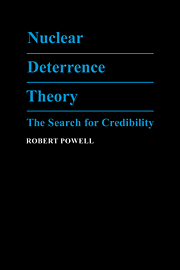Book contents
- Frontmatter
- Contents
- Preface
- 1 Introduction
- 2 The nuclear revolution and the problem of credibility
- 3 The dynamics of nuclear brinkmanship
- 4 Stability and longer brinkmanship crises
- 5 Crisis stability in the nuclear age
- 6 Stability and the lack of control
- 7 The strategy of limited retaliation
- 8 An appraisal
- Appendix Some introductory notes on game theory
- References
- Index
3 - The dynamics of nuclear brinkmanship
Published online by Cambridge University Press: 13 October 2009
- Frontmatter
- Contents
- Preface
- 1 Introduction
- 2 The nuclear revolution and the problem of credibility
- 3 The dynamics of nuclear brinkmanship
- 4 Stability and longer brinkmanship crises
- 5 Crisis stability in the nuclear age
- 6 Stability and the lack of control
- 7 The strategy of limited retaliation
- 8 An appraisal
- Appendix Some introductory notes on game theory
- References
- Index
Summary
The strategy that leaves something to chance and the array of risk link the use or threatened use of force to states' attempts to further their interests. Even in a condition of mutually assured destruction, a state still might be able to use the sanction of launching a massive nuclear attack coercively. A state would no longer threaten to impose this sanction deliberately, but rather to take steps that would raise the risk that the crisis would go out of control and end in disaster. Because no state ever threatens to bring this disaster about deliberately, but only to create some risk of it, then, depending on the stakes involved in the crisis, the threat to take these steps and generate these risks may be quite credible. Crises in this stylization become contests of resolve in which the states compete by taking risks. During a crisis, each state exerts coercive pressure on its adversary by acting in ways that vary the risk of disaster. Eventually, one of the states finds the risk too high and withdraws.
The preceding chapter discussed the general role the array of risk plays in the approach to deterrence based on the strategy that leaves something to chance. That approach attempted to link force or the threat of it to states' efforts to further their ends with a set of limited options that were differentiated on the basis of the autonomous risk that exercising them would generate.
- Type
- Chapter
- Information
- Nuclear Deterrence TheoryThe Search for Credibility, pp. 33 - 84Publisher: Cambridge University PressPrint publication year: 1990



